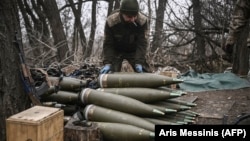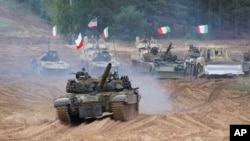
Welcome to Wider Europe, an RFE/RL newsletter focusing on the key issues concerning the European Union, NATO, and other institutions and their relationships with the Western Balkans and Europe's Eastern neighborhoods.
I'm RFE/RL Europe Editor Rikard Jozwiak, and this week I'm drilling down on two issues: How the West can produce more weapons for Ukraine and can frozen Russian assets finally be used to support Ukraine financially?
Brief #1: The Struggle To Get Weapons To Ukraine
What You Need To Know: One of the main challenges for Western allies entering 2024 is the supply of arms to Ukraine, with plenty of worried assessments in recent months from both Ukrainian and NATO officials that stocks are being depleted quickly.
According to estimates, Ukraine fired 7,000 artillery shells a day during the summer; now it uses 2,000. It should arguably be able to match the 10,000 that Russia is firing daily. The worry has been exacerbated by the fact that the United States, by far the biggest single supplier of arms to Ukraine so far, has entered an election year with a promised $60 billion supplemental Ukrainian aid package stalled in Congress as some Republican lawmakers, in particular, remain hesitant.
In fact, Washington has been unable to provide additional munitions to Ukraine so far this year as cash to replenish stockpiles has run out. This meant that, for the first time, the United States on January 23 pledged nothing at the Ukraine Defense Contact Group, a forum of the war-torn country’s biggest military backers that has met 18 times over the last two years to provide Kyiv with arms.
For Ukraine’s allies, this means that other countries need to step up and deliver arms to Ukraine -- mainly on a bilateral basis. This is happening. But both the European Union and NATO are now trying to ramp up production and military aid to Ukraine by pushing for more joint procurement in a bid to create economies of scale.
When speaking to officials in both organizations, there is optimism. The capacity in the West is there, they suggest, and in general, so is the money. Two big question marks remain: Is there enough political will? And can production be increased fast enough?
Deep Background: Last week, the EU’s diplomatic corps, the European External Action Service (EEAS), sent out a discussion paper to EU member states on what the bloc needs to do to support Ukraine militarily “for as long as it takes” – which remains the club’s stated goal.
The paper, seen by RFE/RL, spells out the dangers of European inaction as Russia transforms itself into a war economy, spending 6.5 percent of gross domestic product on defense this year alone: “Russia is investing significant efforts to increase defense industrial production and reconstitute fighting units. Given the dependence of Ukraine on external support, the choices made by the EU Member States and partners in the coming period will either allow Ukraine to decisively progress or will seriously undermine its ability to resist. Uncertainty around the predictable and structured provision of military assistance to Ukraine will have consequential impact on Ukraine.”
Now, the EU has done a fair bit when it comes to arming Ukraine. With the European Peace Facility (EPF), a financing vehicle separate from the regular EU budget in which member states pay contributions in accordance with their gross national income, the bloc has so far provided 3.5 billion euros to send weapons to Ukraine.
On top of that, money from the EPF has also been used to set up an EU mission, EUMAM, which has so far trained 40,000 Ukrainian soldiers on EU territory.
The document notes that: “the Ukraine Armed Forces’ training needs will only increase, given the high rates of attrition and the demanding situation on the front line. In December 2023, President [Volodymyr] Zelenskiy announced an urgent requirement to mobilize a further 500,000 recruits. This will significantly impact the demands on EUMAM to provide basic recruit training along with the commensurate provision of basic equipment.”
Drilling Down
- Then there is the issue of urgently providing Ukraine with 155-millimeter artillery shells. U.S. production of those shells should reach a bit over 1 million a year by 2025. A year ago, the EU said it would provide Ukraine with 1 million shells by March 2024 and committed another 2 billion euros of EPF money toward it.
- With two months to go, it has delivered about half of that, even though EU officials I’ve spoken with still think reaching the stated target is somehow possible. One of the main issues is that most European ammunition makers, unlike many of their U.S. counterparts, are privately owned. They are used to producing fewer, more sophisticated shells. In order to rejig, they want guarantees from the EU in the form of multiyear contracts and stable cash flow.
- With EPF money running out, the EEAS is proposing a top-up of 5 billion euros this year and “further comparable annual increases could be envisaged until 2027.” EU leaders will discuss this issue when they assemble in Brussels for a summit on February 1.
- Don’t expect any decision at that point. But can we expect one at all? You need unanimity for the proposed cash injection. Will Hungary and Slovakia -- two countries that have publicly rejected more weapons for Kyiv – give a green light? Hungary, for example, has been vetoing the current, eighth tranche of EPF money for Ukraine -- worth 500 million euros -- since the summer and shows no indication of lifting it.
- Then there’s Germany. As the biggest EPF contributor, Berlin has questioned the efficacy of the facility, with all its veto opportunities but also because it has been used to reimburse EU countries for sending weapons from existing stocks instead of placing new orders, the latter of which would force the industry to produce more.
- With NATO, things are proceeding a bit more smoothly. Even though individual allies are sending weapons to Ukraine on a bilateral basis, the military alliance is stepping up in terms of joint procurement.
- Its NATO Support and Procurement Agency (NSPA) has agreed contracts worth over $10 billion since July, its biggest spending spree ever, including 200,000 rounds of 155-millimeter ammunition and 1,000 Patriot interceptor missiles for alliance members that could eventually be transported to Ukraine. The problem, however, is time. The shells will be ready in 24-36 months and the Patriots will take even longer.
Brief #2: Will Proceeds From Frozen Russian Assets Finally End Up In Ukraine?
What You Need To Know: Later this week, the European Union is set to take the first legislative step toward using proceeds from frozen Russian assets in the bloc to the benefit of Ukraine. But don’t expect that the cash will flow immediately into Kyiv’s coffers -- and don’t hope for huge sums. This is still a sensitive issue for the EU, as it touches on fundamental legal issues such as private property rights and the status of the common currency, the euro. So expect Brussels to move forward carefully.
The first thing that needs to be pointed out is that the EU right now is only targeting frozen assets of the Russian Central Bank and the Russian National Wealth Fund in the club. These two entities’ assets in the EU were frozen – or “immobilized,” as Brussels refers to it – in the immediate aftermath of Russia’s full-scale invasion of Ukraine in February 2022.
It is estimated that around 200 billion euros has been frozen, most of it in Belgium.
And here comes the second aspect of what the EU is trying to do: It is only the proceeds of these assets that could eventually end up supporting Kyiv; in other words, interest made off of money deposited in those bank accounts. That is thought to mean some 3 billion-5 billion euros a year that could go toward the economic reconstruction of Ukraine.
Deep Background: The reason for such a modest approach is that many of the larger eurozone members (France, Germany, Italy) but also the European Central Bank (ECB) worry what consequences the move might have on the euro -- notably, on its status as the second reserve currency in the world. If the savings of a sovereign country in the euro area can be taken, will that discourage other countries from placing money in the EU? And would that then undermine international trust in the euro?
In order to assuage such fears, a number of steps are being proposed in draft legal acts seen by RFE/RL.
First and foremost, the move would be taken in coordination with partners from the Group of Seven (G7) leading industrial nations. And then the legal basis is spelled out -- so that if Russia took the EU to court, the bloc could respond with solid judicial arguments. Firstly, the legal act spells out that proceeds cannot be considered sovereign assets and don’t need to be returned to Russia if the sanctions are lifted: “the unexpected and extraordinary revenues covered by this Decision do not have to be made available to the Central Bank of Russia under applicable rules after the discontinuation of the transaction prohibition, thus they do not constitute sovereign assets.”
It also enumerates a long list of reasons why the money should go to Ukraine based on considerations including “the legitimate aim of pursuing the objectives of the Common Foreign and Security Policy, in particular consolidation of and support for democracy, the rule of law, human rights and the principles of international law, including international humanitarian law, the preservation of peace, prevention of conflicts and strengthening of international security and the protection of civilian population as well as assisting populations confronting man-made disasters.”
Drilling Down
- What EU ambassadors are likely to endorse at their meeting on January 31 is the first step in a two-step decision-making process. That first step is that the proceeds will be identified and separated from the rest of the frozen assets, something that -- as I understand it from various EU officials familiar with the process -- can happen relatively quickly.
- The second step, however, will not be decided this week. It is whether to actually send the cash to Ukraine. The proposed legal text once again shows Brussels’ cautious approach, stating: “in a second step, the Council should be able to decide how these net profits should be directed to support Ukraine and its recovery and reconstruction, consistent with applicable contractual obligations, and in accordance with EU and international law, in coordination with partners.”
- The text also notes that it is up to the European Commission and the EU foreign policy chief to indicate when this can happen. In a nod to the importance of the ECB in this decision, it is also added that “in the preparation of such proposal, the High Representative (EU foreign policy chief) and the Commission are expected to consult relevant stakeholders and in particular the European Central Bank.”
- The key discussion among EU member states now is centered on how much time should transpire between the first step and the second one. Some hawkish members, notably the three Baltic states and Poland, want a near-immediate move to ensure that money goes to Kyiv. Others want to wait and see, especially if the U.S. and U.K. take similar steps for frozen dollar and pound sterling accounts, as “everyone in the West needs to jump at the same time.”
- Another argument is that such a small amount of money needn’t be sent to Ukraine immediately, as the expectation is that the EU will agree soon on its 50 billion-euro funding for Ukraine for the next four years. If this can be signed into being by EU leaders at a Brussels summit on February 1, there is no real urgency to send the proceeds to Ukraine right now.
Looking Ahead
On January 31, the International Court of Justice (ICJ) will pronounce its verdict in Ukraine's lawsuit against Russia regarding the alleged violation of the conventions on the prohibition of terrorist financing and the elimination of all forms of racial discrimination. The lawsuit was filed back in 2017 -- so before the 2022 full-scale invasion of Ukraine -- and concerns Russian actions in annexed Crimea and parts of Donetsk and Luhansk that have been under Russian occupation since 2014.
A day later, EU leaders will try to agree on a 50 billion-euro ($54 billion) support package for Ukraine for the next four years at an extra summit in Brussels. They had hoped to green-light this back in December but couldn’t overcome Hungary’s objections at the time. This time, the leaders hope to pacify Budapest by allowing some of the cash to go to Kyiv now but giving Hungary veto opportunities on future tranches.
That's all for this week. Feel free to reach out to me on any of these issues on Twitter @RikardJozwiak, or on e-mail at jozwiakr@rferl.org.
Until next time,
Rikard Jozwiak
If you enjoyed this briefing and don't want to miss the next edition, subscribe here.





